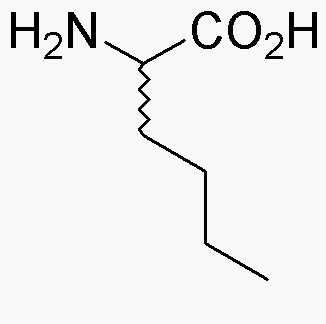DL-Norleucine is widely utilized in research focused on:
- Protein Synthesis: As a non-standard amino acid, it can be incorporated into peptides and proteins, allowing researchers to study the effects of structural variations on protein function.
- Metabolic Studies: It serves as a useful tool in metabolic research, helping scientists understand amino acid metabolism and its implications in various biological processes.
- Pharmaceutical Development: The compound is explored in drug formulation, particularly in designing therapeutics that target specific metabolic pathways, enhancing drug efficacy.
- Food Industry: In food science, it is used to improve the nutritional profile of protein supplements, making them more beneficial for muscle recovery and growth.
- Research on Genetic Disorders: It aids in studying genetic disorders related to amino acid metabolism, providing insights that could lead to potential treatments.
General Information
Properties
Safety and Regulations
Applications
DL-Norleucine is widely utilized in research focused on:
- Protein Synthesis: As a non-standard amino acid, it can be incorporated into peptides and proteins, allowing researchers to study the effects of structural variations on protein function.
- Metabolic Studies: It serves as a useful tool in metabolic research, helping scientists understand amino acid metabolism and its implications in various biological processes.
- Pharmaceutical Development: The compound is explored in drug formulation, particularly in designing therapeutics that target specific metabolic pathways, enhancing drug efficacy.
- Food Industry: In food science, it is used to improve the nutritional profile of protein supplements, making them more beneficial for muscle recovery and growth.
- Research on Genetic Disorders: It aids in studying genetic disorders related to amino acid metabolism, providing insights that could lead to potential treatments.
Documents
Safety Data Sheets (SDS)
The SDS provides comprehensive safety information on handling, storage, and disposal of the product.
Product Specification (PS)
The PS provides a comprehensive breakdown of the product’s properties, including chemical composition, physical state, purity, and storage requirements. It also details acceptable quality ranges and the product's intended applications.
Certificates of Analysis (COA)
Search for Certificates of Analysis (COA) by entering the products Lot Number. Lot and Batch Numbers can be found on a product’s label following the words ‘Lot’ or ‘Batch’.
*Catalog Number
*Lot Number
Certificates Of Origin (COO)
This COO confirms the country where the product was manufactured, and also details the materials and components used in it and whether it is derived from natural, synthetic, or other specific sources. This certificate may be required for customs, trade, and regulatory compliance.
*Catalog Number
*Lot Number
Safety Data Sheets (SDS)
The SDS provides comprehensive safety information on handling, storage, and disposal of the product.
DownloadProduct Specification (PS)
The PS provides a comprehensive breakdown of the product’s properties, including chemical composition, physical state, purity, and storage requirements. It also details acceptable quality ranges and the product's intended applications.
DownloadCertificates of Analysis (COA)
Search for Certificates of Analysis (COA) by entering the products Lot Number. Lot and Batch Numbers can be found on a product’s label following the words ‘Lot’ or ‘Batch’.
*Catalog Number
*Lot Number
Certificates Of Origin (COO)
This COO confirms the country where the product was manufactured, and also details the materials and components used in it and whether it is derived from natural, synthetic, or other specific sources. This certificate may be required for customs, trade, and regulatory compliance.


